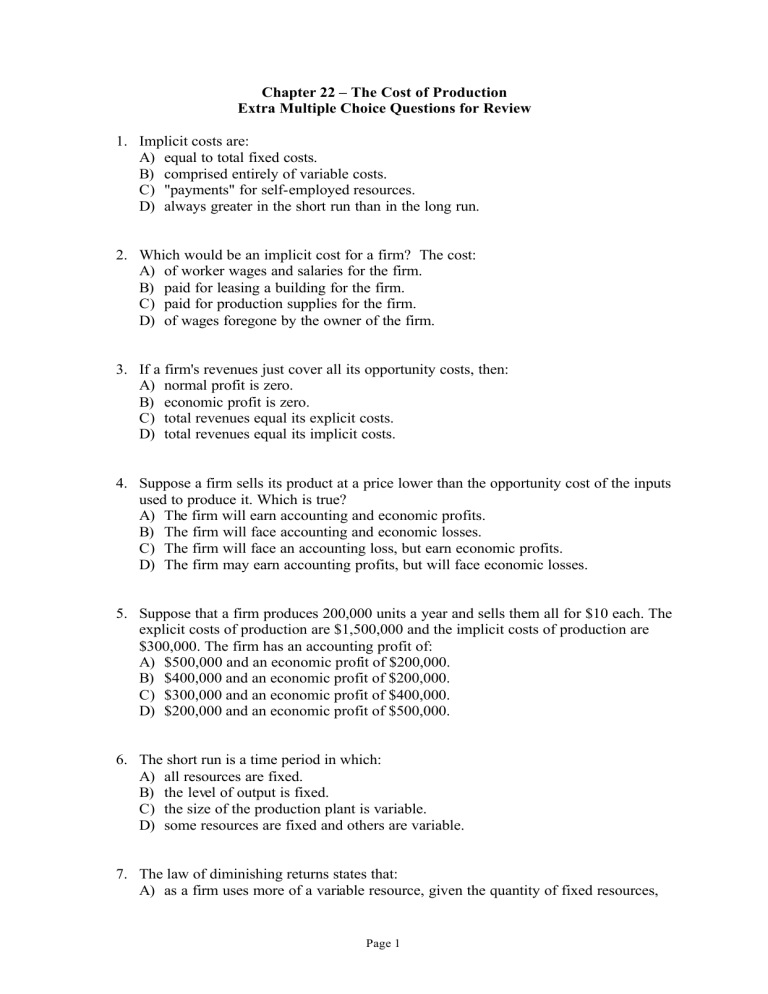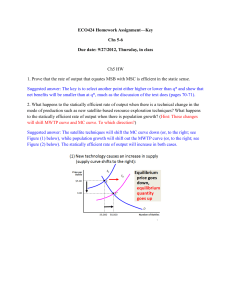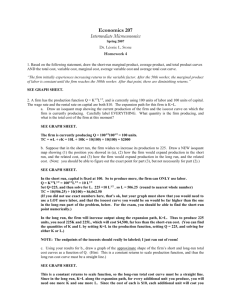Chapter 22 – The Cost of Production Extra

Chapter 22 – The Cost of Production
Extra Multiple Choice Questions for Review
1. Implicit costs are:
A) equal to total fixed costs.
B) comprised entirely of variable costs.
C) "payments" for self-employed resources.
D) always greater in the short run than in the long run.
2. Which would be an implicit cost for a firm? The cost:
A) of worker wages and salaries for the firm.
B) paid for leasing a building for the firm.
C) paid for production supplies for the firm.
D) of wages foregone by the owner of the firm.
3. If a firm's revenues just cover all its opportunity costs, then:
A) normal profit is zero.
B) economic profit is zero.
C) total revenues equal its explicit costs.
D) total revenues equal its implicit costs.
4. Suppose a firm sells its product at a price lower than the opportunity cost of the inputs used to produce it. Which is true?
A) The firm will earn accounting and economic profits.
B) The firm will face accounting and economic losses.
C) The firm will face an accounting loss, but earn economic profits.
D) The firm may earn accounting profits, but will face economic losses.
5. Suppose that a firm produces 200,000 units a year and sells them all for $10 each. The explicit costs of production are $1,500,000 and the implicit costs of production are
$300,000. The firm has an accounting profit of:
A) $500,000 and an economic profit of $200,000.
B) $400,000 and an economic profit of $200,000.
C) $300,000 and an economic profit of $400,000.
D) $200,000 and an economic profit of $500,000.
6. The short run is a time period in which:
A) all resources are fixed.
B) the level of output is fixed.
C) the size of the production plant is variable.
D) some resources are fixed and others are variable.
7. The law of diminishing returns states that:
A) as a firm uses more of a variable resource, given the quantity of fixed resources,
Page 1
the average product of the firm will increase.
B) as a firm uses more of a variable resource, given the quantity of fixed resources, marginal product of the firm will eventually decrease.
C) in the short run, the average total costs of the firm will eventually diminish.
D) in the long run, the average total costs of the firm will eventually diminish.
8. The law of diminishing returns only applies in cases where:
A) there is increasing scarcity of factors of production.
B) the price of extra units of a factor is increasing.
C) there is at least one fixed factor of production.
D) capital is a variable input.
9. The marginal product of labor curve shows the change in total product resulting from a:
A) one-unit increase in the quantity of a particular resource used, letting other resources vary.
B) one-unit increase in the quantity of a particular resource used, holding constant other resources.
C) change in the cost of a variable resource.
D) change in the cost of a fixed resource.
10. When the total product curve is falling, the:
A) marginal product of labor is zero.
B) marginal product of labor is negative.
C) average product of labor is increasing.
D) average product of labor must be negative.
11. When marginal product reaches its maximum, what can be said of total product?
A) total product must be at its maximum
B) total product starts to decline even if marginal product is positive
C) total product is increasing if marginal product is still positive
D) total product levels off
12. Variable costs are:
A) sunk costs.
B) multiplied by fixed costs.
C) costs that change with the level of production.
D) defined as the change in total cost resulting from the production of an additional unit of output.
13. Which is not a fixed cost?
A) monthly rent of $1,000 contractually specified in a one-year lease
B) an insurance premium of $50 per year, paid last month
C) an attorney's retainer of $50,000 per year
Page 2
D) a worker's wage of $15 per hour
14. If you know that with 8 units of output, average fixed cost is $12.50 and average variable cost is $81.25, then total cost at this output level is:
A) $93.75. B) $97.78. C) $750. D) $880.
15. With fixed costs of $400, a firm has average total costs of $3 and average variable costs of $2.50. Its output is:
A) 200 units. B) 400 units. C) 800 units. D) 1,600 units.
16. The reason the marginal cost curve eventually increases as output increases for the typical firm is because:
A) of diseconomies of scale.
B) of minimum efficient scale.
C) of the law of diminishing returns.
D) normal profit exceeds economic profit.
17. If the short-run average variable costs of production for a firm are rising, then this indicates that:
A) average total costs are at a maximum.
B) average fixed costs are constant.
C) marginal costs are above average variable costs.
D) average variable costs are below average fixed costs.
18. If a more efficient technology was discovered by a firm, there would be:
A) an upward shift in the AVC curve. C) a downward shift in the AFC curve.
B) an upward shift in the AFC curve. D) a downward shift in the MC curve.
19. The firm's short-run marginal-cost curve is increasing when:
A) marginal product is increasing.
B) marginal product is decreasing.
C) total fixed cost is increasing.
D) average fixed cost is decreasing.
Page 3
20. A firm encountering economies of scale over some range of output will have a:
A) rising long-run average cost curve.
B) falling long-run average cost curve.
C) constant long-run average cost curve.
D) rising, then falling, then rising long-run average cost curve.
21. When a firm doubles its inputs and finds that its output has more than doubled, this is known as:
A) economies of scale.
B) constant returns to scale.
C) diseconomies of scale.
D) a violation of the law of diminishing returns.
22. The larger the diameter of a natural gas pipeline, the lower is the average total cost of transmitting 1,000 cubic feet of gas 1,000 miles. This is an example of:
A) economies of scale.
B) normative economies.
C) diminishing marginal returns.
D) an increasing marginal product of labor.
23. If all resources used in the production of a product are increased by 20 percent and output increases by 20 percent, then there must be:
A) economies of scale. C) constant returns to scale.
B) diseconomies of scale. D) increasing average total costs.
24. Economies and diseconomies of scale explain why the:
A) short-run average fixed cost curve declines so long as output increases.
B) marginal cost curve must intersect the minimum point of the firm's average total cost curve.
C) long-run average total cost curve is typically U-shaped.
D) short-run average variable cost curve is U-shaped.
Page 4
Use the following to answer question 25:
Unit
Costs
Long Run ATC
Q1 Q2 Q3 Q4
25.In the graph above, minimum efficient scale occurs at:
Quantity Produced
A) Q
1
. B) Q
2
. C) Q
3
. D) Q
4
.
Page 5
Answer Key -- ch22
1. C
2. D
3. B
4. D
5. A
6. D
7. B
8. C
9. B
10. B
11. C
12. C
13. D
14. C
15. C
16. C
17. C
18. D
19. B
20. B
21. A
22. A
23. C
24. C
25. B
Page 6








